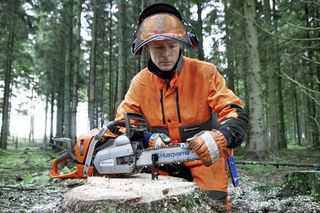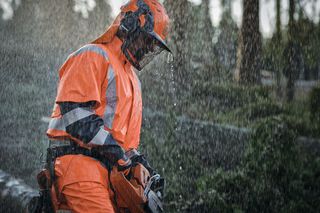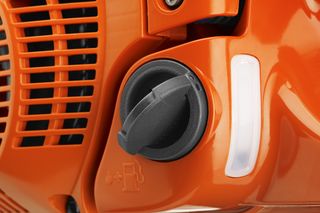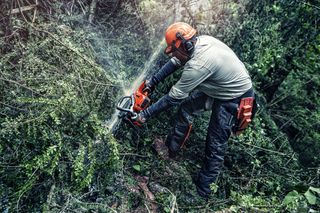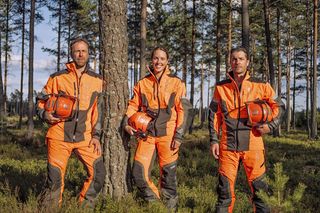
Working with Chainsaws - a Beginners Guide
Chainsaws are devices that deserve our full respect. They get the job done, but we must handle them with proper care. If you’re new to the cutting game and don’t know where to start, you’ve come to the right place. We’re sharing everything you need to know to get started with your first chainsaw.
Know Your Limits
You should never use a chainsaw if you’re not feeling confident with the tool in your hands. If you feel like the task at hand is too much for you make sure you contact a professional to help you out.
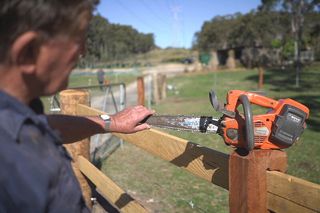
Choosing The Right Chainsaw
If you’re an absolute beginner, then you should consider a lighter chainsaw, suitable for minor cutting jobs around the garden.
The Husqvarna 120e Mark II is a reliable, all-round chainsaw; perfect for homeowners with little to no cutting experience. It’s ideal for cutting firewood and light felling. Features the powerful—yet environmentally-friendly—X-Torq engine.
More demanding cutting jobs would require a more powerful chainsaw. The Husqvarna 445 e-series II is an incredibly powerful, 18’’ bar chainsaw that’s easy to start and handle. The X-Torq® engine limits fuel consumption and reduces emission levels.
If you’ll only settle for the best, then you should get your hands on the next generation chainsaw, Husqvarna’s 572 XP®—a chainsaw made for those who want it all. With a powerful 4.3kW engine, this powerhouse of a chainsaw will cut through any thick log with remarkable ease. Its excellent cooling and heavy-duty filtration offer great endurance and performance.

Before You Get Started
Before you turn the engine on and start cutting, you need to make sure the chainsaw is in perfect condition. Here’s a checklist that you should always run through before operating your machine:
- All the parts are properly lubricated.
- The chain has the correct tension.
- The teeth are as sharp as possible.
- All safety devices and equipment are in place.
- There are no loose parts or bolts
Scan Your Work Area
Before you begin operating your chainsaw, make sure your work area is clear of any obstacles or people. If you’re working on your garden, ensure that children have no access to the area.
Check that nothing could fall on you while you’re cutting, such as debris from a tall tree. When starting the chainsaw, use only cold or warm start positions. Drop-starting a saw could result in a serious injury.
Watch For Kickback
Kickback can happen at any time and can catch beginners off guard. It usually happens when the bar nose hits a solid object or when the chain is too loose. Modern chainsaws, such as those made by Husqvarna, come equipped with a protective guard in front of the handle to prevent injury from kickback. To reduce the chance of kickback:
- Always hold the chainsaw firmly with both hands.
- Make sure the tip of the chainsaw doesn’t touch any objects.
- Take extra caution when cutting twigs and other light material.
- Be cautious when re-entering a cut.

Safe Operation
There are only two correct ways to start a chainsaw. Either by placing the chainsaw on the ground or by keeping it between your legs. To cold-start a chainsaw:
- Make sure the chain brake is activated.
- Activate decompression control if available.
- Activate the choke.
- Place your right foot on the back handle and hold the front handle firmly with your left hand. If you’re starting the saw between your legs, place the back handle between your thighs and hold the front handle firmly with your left hand.
- Pull the starter handle with your right hand until the engine fires.
- Push the choke and pull until the saw starts.
- Release the chain brake.
If you’re starting your Husqvarna chainsaw while the engine is still hot, simply set the choke mechanism to the full choke position and then flick it back off before pulling the starter handle.
Holding The Saw
Always hold the saw with both hands, keeping it close to your body. Do not adjust the chainsaw or change your position while the engine is still running. If you need to pause and continue later, turn the engine off and initiate a warm start when you’re ready to continue.
Cutting Habits
Keeping the saw nice and steady should be your number one priority. Refrain from cutting anything that’s above shoulder length. Chainsaws are heavy machines that are not designed to be used on weird angles. If you can’t reach it, you shouldn’t be cutting it.
- Maintaining Your Saw
- Taking good care of your saw will extend its life and make it much easier and safer to use. Once you’re done cutting:
- Make sure that all the important mechanisms (air filter, chain brake) are free from sawdust.
- Thoroughly clean the guide bar.
- Oil the holes and double-check to ensure everything is where it should be.
- Keep the chain sharp, well-oiled, and properly tensioned. Husqvarna’s Mineral Chain Oil provides maximum lubrication, extending the life of your chain as a result.

Use Protective Equipment
No matter how careful you are with your chainsaw, accidents can happen. Equipping yourself with the right protective equipment could mean the difference between a minor accident and a major injury. Don’t leave things to chance. When cutting, make sure you’re wearing:
A protective helmet. Husqvarna’s lightweight and ventilated polycarbonate Forest Helmet is perfect for any cutting job. It comes equipped with hearing protection, sun peak and neck guard. The UltraVision visor offers a 20% light reduction for a clearer view.
Protective clothing. Husqvarna’s new line of protective clothing is designed to keep you comfortable and safe at the same time. Several openings make for good ventilation, while ergonomic zippers and straps allow you to adjust your gear for a perfect fit.
Protective boots. Husqvarna’s Protective boots, Functional 24 provide maximum saw protection with reinforced toe-cap and non-slip sole.
Visual protection. Husqvarna’s wide range of safety glasses, goggles and visors keep your eyes away from dangerous flying sawdust.
Hearing protection. If your protective helmet did not come with hearing protection, a comfortable set of earmuffs is a must.
Think Before You Cut
Thinking about the task before attempting to cut anything can help prevent accidents. Never cut anything other than wood and remain alert all throughout the cutting procedure. If you feel tired at any point, turn the engine off and rest.
